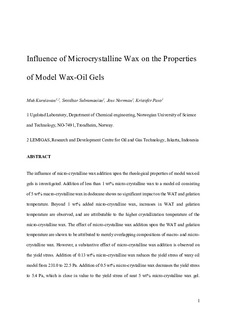| dc.contributor.author | Kurniawan, Muh | |
| dc.contributor.author | Subramanian, Sreedhar | |
| dc.contributor.author | Norrman, Jens | |
| dc.contributor.author | Paso, Kristofer Gunnar | |
| dc.date.accessioned | 2019-03-18T09:13:39Z | |
| dc.date.available | 2019-03-18T09:13:39Z | |
| dc.date.created | 2019-02-25T09:12:12Z | |
| dc.date.issued | 2018 | |
| dc.identifier.citation | Energy & Fuels. 2018, 32 (5), 5857-5867. | nb_NO |
| dc.identifier.issn | 0887-0624 | |
| dc.identifier.uri | http://hdl.handle.net/11250/2590409 | |
| dc.description.abstract | The influence of microcrystalline wax addition upon the rheological properties of model wax-oil gels is investigated. Addition of less than 1 wt % microcrystalline wax to a model oil consisting of 5 wt % macrocrystalline wax in dodecane shows no significant impact on the WAT and gelation temperature. Beyond 1 wt % added microcrystalline wax, increases in WAT and gelation temperature are observed and are attributable to the higher crystallization temperature of the microcrystalline wax. The effect of microcrystalline wax addition upon the WAT and gelation temperature is shown to be attributed to merely overlapping compositions of macro- and microcrystalline wax. However, a substantive effect of microcrystalline wax addition is observed on the yield stress. Addition of 0.13 wt % microcrystalline wax reduces the yield stress of the waxy oil model from 238.0 to 22.5 Pa. Addition of 0.5 wt % microcrystalline wax decreases the yield stress to 5.4 Pa, which is close in value to the yield stress of neat 5 wt % microcrystalline wax gel. Microscopic images reveal two mechanisms leading to formation of weak mixed wax gels. At low to medium addition of microcrystalline wax, microcrystalline crystallites formed during cooling provide nucleation sites for subsequent precipitation of macrocrystalline wax. Macrocrystalline wax crystals formed in contact with microcrystalline crystallites are smaller in size and the growth is localized, in comparison to neat macrocrystalline wax. Modified macrocrystalline wax precipitation leads to uneven dispersion of the macrocrystalline crystals in the liquid phase. At high concentration, microcrystals form throughout the sample prior to precipitation of macrocrystalline wax. Hence, only a small and discrete space remains for macrocrystalline crystals to grow, forming small crystals. Interlocking among macrocrystals is spatially hindered by the presence of microcrystalline crystallites. In this condition, the system completely behaves as a microcrystalline gel. This investigation provides a plausible mechanistic account for the known gel weakening activity of microcrystalline wax. | nb_NO |
| dc.language.iso | eng | nb_NO |
| dc.publisher | American Chemical Society | nb_NO |
| dc.title | Influence of Microcrystalline Wax on the Properties of Model Wax-Oil Gels | nb_NO |
| dc.type | Journal article | nb_NO |
| dc.type | Peer reviewed | nb_NO |
| dc.description.version | acceptedVersion | nb_NO |
| dc.source.pagenumber | 5857-5867 | nb_NO |
| dc.source.volume | 32 | nb_NO |
| dc.source.journal | Energy & Fuels | nb_NO |
| dc.source.issue | 5 | nb_NO |
| dc.identifier.doi | 10.1021/acs.energyfuels.8b00774 | |
| dc.identifier.cristin | 1680260 | |
| dc.description.localcode | © American Chemical Society 2018. This is the authors accepted and refereed manuscript to the article. Locked until 23.04.2019 due to copyright restrictions. | nb_NO |
| cristin.unitcode | 194,66,30,0 | |
| cristin.unitname | Institutt for kjemisk prosessteknologi | |
| cristin.ispublished | true | |
| cristin.fulltext | postprint | |
| cristin.qualitycode | 2 | |
